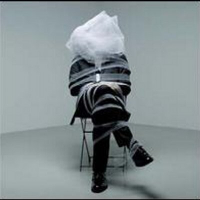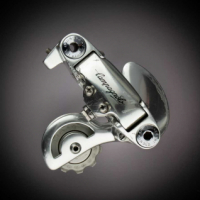2018 Gear
Comments
-
It's marginal gains taken to the extreme but there is a trend for huge jockey wheels fir this reason. Can't see pro mechanics wanting to fit 10 sprockets. The only way I see it working is in racing where you don't use the little ring. Pro aren't going to like jumps in the cassette.
Anyway it's already gained lots of publicity so it's worked .0 -
Mad_Malx wrote:As described, 9 tooth cassettes now exist, but need different hubs.
Friction increases with small cogs because the chain doubles back more, which isn't a problem with jockey wheels. Friction and efficiency loss also increases with chain angle. So you loose power using small cogs. Some Tters prefer 55 up front, so they can keep a better chainline most of the time (i.e. Avoid the smallest cogs).
Br did this on it a while back
http://www.bikeradar.com/road/gear/arti ... ing-44016/
The differences are very small though.
If the nut is LOOSE you might LOSE it.0 -
Losen up!0
-
Ummm, footloose.0
-
Anyone worked out if it weighs more or less yet?
And is the efficiency gained from 30mms bigger then the extra rotating mass cost?0 -
What if they flat and need a spare wheel from the neutral service vehicles?0
-
Exactly wrong. http://sportsscientists.com/2014/07/pro ... int-stage/inseine wrote:
ExactlyGweeds wrote:60kph is nowhere near enough.
Sprint speeds average 66kph, with an upper maximum of 70kph. The issue is cadence. If you can spin 48x11 at 120-130rpm, you're in a good place; otherwise 48x10 at 110-120rpm.
It might help you to know that Chris Hoy rode a 51x14 most of the time. That's a considerably smaller gear than 48x11. In fact it's almost exactly 40x11.Hoy Q&A in 2006 wrote:
"If it's not a trade secret, what gears do you ride?"
"For the Kilometre it's virtually always 51 x 14, maybe a little lower for a big, old outdoor track, maybe a little higher at altitude. In the team sprint it's 51 x 14 and for the individual sprint 50 x 14."
Hoy holds the current WR for the flying 500m in 24.758; that's 72.7km/h. Cadence just under 160.
Pros are expected to be able to spin 180-200 (not saying that's optimum, but it's part of the training); apparently a GB track sprinter has been measured at 260rpm. On the grounds that the peloton is normally rolling at about 50km/h, which is a 100 cadence in 48x12, it looks like the really silly cadences would only be needed to contest the sprint. And, of course, I made up the 48 front ring; perhaps they'll use a 50 or 52, and a wider-range cassette - 52x40 is about the same as 39x28.0 -
What has this got to do with track racing? Chalk and cheese964Cup wrote:
Exactly wrong. http://sportsscientists.com/2014/07/pro ... int-stage/inseine wrote:
ExactlyGweeds wrote:60kph is nowhere near enough.
Sprint speeds average 66kph, with an upper maximum of 70kph. The issue is cadence. If you can spin 48x11 at 120-130rpm, you're in a good place; otherwise 48x10 at 110-120rpm.
It might help you to know that Chris Hoy rode a 51x14 most of the time. That's a considerably smaller gear than 48x11. In fact it's almost exactly 40x11.Hoy Q&A in 2006 wrote:
"If it's not a trade secret, what gears do you ride?"
"For the Kilometre it's virtually always 51 x 14, maybe a little lower for a big, old outdoor track, maybe a little higher at altitude. In the team sprint it's 51 x 14 and for the individual sprint 50 x 14."
Hoy holds the current WR for the flying 500m in 24.758; that's 72.7km/h. Cadence just under 160.
Pros are expected to be able to spin 180-200 (not saying that's optimum, but it's part of the training); apparently a GB track sprinter has been measured at 260rpm. On the grounds that the peloton is normally rolling at about 50km/h, which is a 100 cadence in 48x12, it looks like the really silly cadences would only be needed to contest the sprint. And, of course, I made up the 48 front ring; perhaps they'll use a 50 or 52, and a wider-range cassette - 52x40 is about the same as 39x28.0 -
Track sprinters != road sprinters0
-
Speed is speed. Gearing is gearing. I'm merely trying to demonstrate that you can ride at current road peloton speed on a 1x11 drivetrain with a reasonable spread of ratios. Some track riders have been known to succeed on the road; and indeed vice versa. Are you saying they became entirely different people in so doing?0
-
Oh, and Elia Viviani, while I think about it. Or does he have an identical twin?0
-
Cav;
He used a 54×11 on stage one to Utah Beach, a decision no doubt taken by the fast run-in to the finish.
Conversely, Etixx-Quick Step manager Patrick Lefevere said afterwards that Marcel Kittel probably needed a similar gear, instead of a 53 on the front.0 -
Just saying that it's ok to sprint at 180rpm if you can have a little sit down after 10 seconds. Road sprints last many kilometers and there could have been several sections of the previous 200 or 300k where they're at 80-90kph. They just don't train to do mega leg speeds964Cup wrote:Oh, and Elia Viviani, while I think about it. Or does he have an identical twin?0 -
HatIt's only a bit of sport, Mun. Relax and enjoy the racing.0
-
0
-
964Cup wrote:snip..
Pros are expected to be able to spin 180-200 (not saying that's optimum, but it's part of the training); apparently a GB track sprinter has been measured at 260rpm. On the grounds that the peloton is normally rolling at about 50km/h, which is a 100 cadence in 48x12, it looks like the really silly cadences would only be needed to contest the sprint. And, of course, I made up the 48 front ring; perhaps they'll use a 50 or 52, and a wider-range cassette - 52x40 is about the same as 39x28.
I doubt many in the peloton go over 120rpm to be honest, maybe Froome when he's in rocket hill mode0 -
[deleted - I'm colourblind and mistook speed for cadence - I think]0
-
Revised version: have a look at http://www.srm.de/news/road-cycling/?tx ... 87eb70fa1a. Lots of cadence data there, but I can't reliably see the colour difference between the speed and cadence traces, so I'm not going to draw conclusions.
The original point, if we all recall, was that Aqua Blue are going to ride 1x11 (or, I suppose, possibly 1x12) next year. Are they going to spin like loons, or have enormous rear cassettes and big gaps at the lower end?0 -
964Cup wrote:Revised version: have a look at http://www.srm.de/news/road-cycling/?tx ... 87eb70fa1a. Lots of cadence data there, but I can't reliably see the colour difference between the speed and cadence traces, so I'm not going to draw conclusions.
The original point, if we all recall, was that Aqua Blue are going to ride 1x11 (or, I suppose, possibly 1x12) next year. Are they going to spin like loons, or have enormous rear cassettes and big gaps at the lower end?
Cadence(Blue) very rarely gets above 110rpm in any stage for most riders, Heart rate (red) does get to 180-200.
So max practical cadence is around 90-100rpm0 -
kleinstroker wrote:So max practical cadence is around 90-100rpm
Tell that to milemuncher.
That 'thing' is a cassette on one of those off roads contraptions.seanoconn - gruagach craic!0 -
Well, for anyone interested, here are comparisons between a 39-53 11-28 setup and a 44t 9-32 cassette setup, as is probably likely to be in use here.
Here's a link to more information about the cassettes:
http://www.bikeradar.com/au/road/news/a ... tte-50278/
Comparison with the 'overdrive' cassette.
http://www.gear-calculator.com/?GR=DERS ... 2&UF2=2135
Comparison with the 'bailout' cassette.
http://www.gear-calculator.com/?GR=DERS ... 2&UF2=21350 -
-
Rick Chasey wrote:So is it lighter?
If not, what's the point?
Less components in the gruppo and if it's Campag SR EPS, that's a saving of oooh, £600.seanoconn - gruagach craic!0 -
 “Among bicycles equipped with a single front sprocket and a plurality of rear sprockets, gear shifting has been conventionally carried out by operation of a rear derailleur. When a gear shifting operation is performed by operation of the rear derailleur, chances are that a chain is disposed in an oblique position relative to the faces of the front sprocket while being wound around the front sprocket and any of the rear sprockets. When the chain is disposed in an oblique position while being wound around the front sprocket and any of the rear sprockets, it is concerned that the chain may be disengaged from the front sprocket. In light of this concern, a conventional construction has been proposed for making the chain unlikely to be disengaged from the front sprocket. In this conventional construction, the front sprocket is configured to be movable in an axial direction arranged in parallel to a rotational center axis whereby the chain is unlikely to be disposed in an extremely oblique position.”
“Among bicycles equipped with a single front sprocket and a plurality of rear sprockets, gear shifting has been conventionally carried out by operation of a rear derailleur. When a gear shifting operation is performed by operation of the rear derailleur, chances are that a chain is disposed in an oblique position relative to the faces of the front sprocket while being wound around the front sprocket and any of the rear sprockets. When the chain is disposed in an oblique position while being wound around the front sprocket and any of the rear sprockets, it is concerned that the chain may be disengaged from the front sprocket. In light of this concern, a conventional construction has been proposed for making the chain unlikely to be disengaged from the front sprocket. In this conventional construction, the front sprocket is configured to be movable in an axial direction arranged in parallel to a rotational center axis whereby the chain is unlikely to be disposed in an extremely oblique position.”
https://cyclingindustry.news/shimano-an ... alignment/
Already posted in 2017 gear.
viewtopic.php?f=40002&t=13070334&start=980
I thought this was a good idea especially given crossover replicas and current 12 speed cassettes. Basically a sliding front 1x chain ring /chainset to keep an efficient chain line. I'm sure it's not as easy as it sounds to get working efficiently and reliably.0 -
Just seems to be a solution looking for a problem.
I can't see the performance advantage for a pro team.0 -
A true chainline would be more efficient, that's an advantage. Weight isnt an issue with UCI regs.0
-






